K.V. Johansen's Blog, page 5
April 9, 2014
Ad Astra, part three
Panel the Third, and Panel the Fourth: “Non-European Fantasy Worlds” and “Good Research Makes for Better World-Building”
I’m running my report on these two together, because they’re really quite closely linked. The first panel consisted of me, Steven Erikson, Derwin Mak, and Douglas Smith; the second me, Erikson, Derek Kunsken, Julie E. Czerneda, and David Weber. 
Blinded by the light. Non-European Fantasy Worlds. After some hassle, we got the lighting guy to turn off the eye-damaging spotlights.
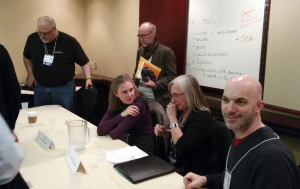
The research conversation carries on after the panel ends.
In both, much of the discussion centred on doing good research. Histories, archaeology, personal travel, and scientific speculation were all discussed. Douglas Smith talked about dealing honestly and respectfully with another culture when writing primary world fantasy about traditions not your own. Erikson made the point that part of the purpose of fantasy was the broadening of horizons that exploring the unfamiliar and unknown brings, while I talked a bit about how the past is just as foreign as another place and that as authors, we need to do just as much research when incorporating elements of the past culture of our own ancestors as of someone else’s. In the world-building panel, Erikson had some rather blood-chilling war-stories of being an archaeologist in Central America in the eighties. Weber talked about the challenges of keeping track of his own technology. Czerneda told the story of building a model of her village of Marrowdell to ensure that the descriptions of light and shadows — essential to the plot and magic in A Turn of Light — would be accurate, while Kunsken described how he’d taken up the challenge of creating plausible life on a planet where a book told him it couldn’t exist. As a bonus, Derwin Mak’s moderating of the “Non-European Fantasy Worlds” panel, by breaking down the programme description into separate questions and working up and down the table to invite each author’s response, before taking questions from the audience, was very instructive. Next time I get volunteered for such a role, I’ll know better what I’m doing.And the fun stuff . . . not that the panels weren’t fun!
My friend MC and I also attended some other events. Greenwood and Erikson discussing epic fantasy was particularly interesting, in a conversation that ranged over quite a long history, from Gilgamesh and the purpose of epic, to the current obsession with ‘grimdark’ and what that might say about contemporary society. We wandered through the dealers’ room several times, being particularly taken with the beautiful work of Irina at Black Currant Jewelry, and visited Bakka’s table. We took a short shift manning the SF Canada table while Ira had a snack break. Emboldened by one another, we also took an hour-long belly dance lesson. (We are not good at belly dance. We will not be giving up engineering or writing in the near future.) We attended Julie E. Czerneda’s reading from A Play of Shadow, sequel to her fantasy A Turn of Light. And finally, on Sunday, we met up with my friend and manga partner Connie Choi (yes, the manga version of “The Storyteller” is still alive, just in hibernation, since Connie’s a full-time student at present), and after some posing by a spiffy replica TARDIS and Dalek, abandoned the con for supper and some serious writing-and-art talk. 
My friend and expedition photographer MC looking ready to be whisked away for adventure. That Dalek is huge and scary. I don’t trust those museum exhibit velvet ropes to hold it back.
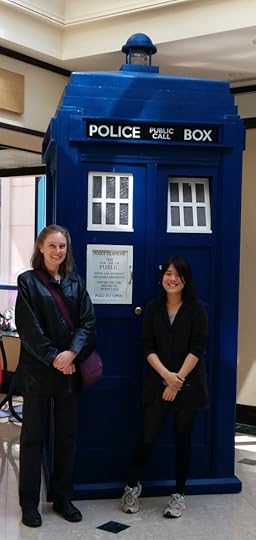
Connie and I and a replica TARDIS. We think it was a replica. We couldn’t check, because the door was locked.


April 8, 2014
Ad Astra, Part Two
Panel the Second: “Judging a Book by its Cover”
This was a really interesting one. I mentioned the lack of officially-appointed moderators in the previous post, right? So, Ed Greenwood appointed me moderator. What? I don’t know what I’m doing … so the audiences I have most experience dealing with are kids … I’ll just assume the same techniques can keep a panel going …. Well, we all survived. My faithful friend who trailed after me throughout the whole con said this one was the most fun from the uninvolved spectator’s point of view.
Ed Greenwood certainly kept things lively.
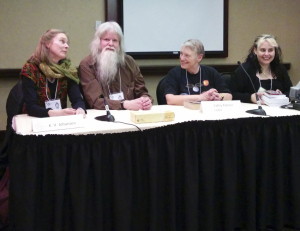
“Seriously?” The cover art panel — lots of fun.
This one contained, in addition to myself, Cathy Palmer-Lister, who brought the reader and book-buyer’s perspective to the table, the one and only Ed Greenwood, and Jen Frankel, who writes, illustrates and publishes the “Blood & Magic” series, as well as being involved in screenwriting. The discussion was wide-ranging and covered things such as what first attracts a reader’s attention, how covers can convey the mood of the story and invite further exploration, the history of cover art in sf, bikini mail and loincloths, those beautiful landscape-based British covers of the eighties and nineties, the changing expectations of both readers and publishers, and current trends, some for the better, some … not. (Paper-doll teens in Photoshop-applied clothes; bloke in cloak and chick in leather pants, right? We’ve all seen them. Over and over and over and …)
This was definitely the panel on which the participants laughed the most. We wandered down a few tangentially-related byways, too, into a shared enthusiasm for the original Nancy Drew stories, among other things. Ed Greenwood’s decades-long experience as reader, author, and librarian was definitely a vital element of this discussion.
more to come in part three …


Ad Astra 2014, Part One
Ad Astra . . . where to begin?
I set off after a three-day storm, heading west to where I hoped it might, possibly, be spring, and arrived in a grey, muddy, early-spring Toronto with cardinals singing all over the backyards in the tree-filled neighbourhood where I was staying. (Not, technically, part of Toronto, but part of the great sprawl that has devoured all the countryside and towns around-about.) The first night was a chance for three old undergrad friends to meet up and discover we could still talk for hours, and the day after that, a chance to do some writing, keeping house with the cats while my friend was at work, but on Friday we two con-goers set off in high spirits and, on my part, some nervousness. Though I do quite a number of readings every year and not a few workshops, I have been on only one con panel before, and it was a very long time ago at a very small con. At Ad Astra I was on four, and the programming people confessed that they had forgotten to appoint moderators, though they were sure we’d all sort it out . . . .
Panel the First: “Self-Promotion on the Social Media Soapbox”
I was on this one with Beverly Bambury, a publicist, indie author Ellie Di Julio, and Linda Poitevin, author of The Grigori Legacy, among other things.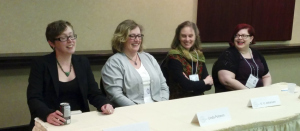
The Social Media Panel
Self-promotion is not a field in which I excel, so part of what I was there to contribute was the perspective of someone who really isn’t into that sort of thing with any passion — but who really likes Twitter for the way it lets me keep in touch with people with whom I enjoy talking, and with what’s going on in my field(s). From some points of view I’m very much living in a backwater, so I can definitely testify to the usefulness of some forms of social media in keeping in touch with the wider world. Others were better able to talk about ways to use Facebook and Tumblr. Then there was quite a lot of discussion of Google+ and some devoted advocacy for it, which I found interesting, as just that morning some of the people I hang out with on Twitter had been discussing whether or not Google+ had died yet. Did we conclude anything useful to the audience? Mostly that the utility of various social media platforms for connecting with one’s readers was going to vary from author to author, depending on both one’s temperament and where one’s particular pool of readers tended to hang out. (So, I’m a Twitter person, and you can find me here.)
to be continued …


The Storyteller contest winners!
Whoops, I just realized I never did post the winners in that contest from last month, to win copies of The Storyteller. (One winner asked if they could substitute a Torrie and the Dragonslayers, as they already had The Storyteller.) Their prizes have long been delivered, but here is the official announcement, for the record. The lucky winners, who knew that Moth in fact appears on the cover of Blackdog as the white bird with elements of both owl and hawk, were Meghan, Katie, and Felix. Hooray! Three cheers, etc.! I hope you’re all enjoying your books.


March 29, 2014
Con Number One: Off to Toronto for Ad Astra 2014
Well, I’m off to Toronto this coming week, to attend Ad Astra, the first stop in my year of cons. Some authors seem to hit a con a month (at least, that’s the impression I get from the chatter on Twitter!), but for me, even getting to two or three is tricky, so I’m pretty excited. I haven’t been to Toronto (not counting that dreadful plane-voyage where I was benighted on my way to Macedonia), since . . . um . . . well, I lived there for a year back in the last century.
It should be a lot of fun. I’m staying with a good friend, catching up with some other people I haven’t seen in years, and maybe hearing a rehearsal of the Amadeus Choir, among non-con things. At Ad Astra, I’m on several panels, ones discussing social media for authors, cover art, non-European fantasy worlds, and research in world-building. I’m pretty excited about all of those, but especially the latter two — looking forward to some really interesting discussions there.
Plus, it’s Toronto: mochi, canned sweet red beans and ajvar and pindjur in the grocery stores — I’m going grocery shopping.


March 19, 2014
Contest winners
Winners in the “on which Swanland/Pyr cover other than The Lady does Moth appear (and in what form)” contest have been chosen! And weirdly, they were all Canadians.
The first entry winner was Meghan from Saskatoon.
In the random draw, Mr Wicked got carried away and selected two winners from further east, Felix and Katie.
Congratulations! Spiffy copies of The Storyteller will be coming to you soon.


March 11, 2014
Cover Art for The Lady: Marakand Volume Two
Three rousing cheers and a city in ruins: the cover art for The Lady had been released!
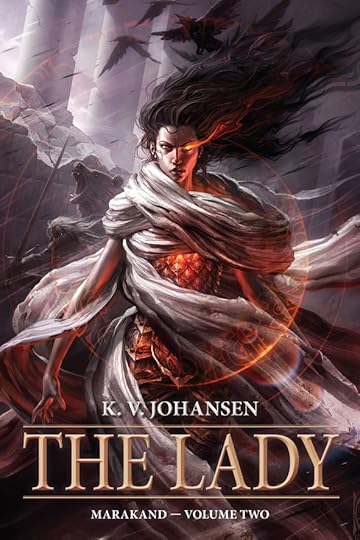
The Lady: Marakand Part Two, cover art by Raymond Swanland
This is the second part of Marakand and continues the story of the assassin Ahjvar, his shield-bearer Ghu, and the temple-dancer Zora begun in The Leopard. The Leopard comes out in June 2014, The Lady in December, and both can be pre-ordered now. Just follow the link to my website, my children, and let the countdown till publication day begin!
The cover shows (naturally) the Lady of Marakand. Is she not beautiful and terrible? Cover artist Raymond Swanland has also included, in the background, Moth, her first appearance on a Pyr cover in human form, and Mikki is lurking there too.
Tell you what, let’s have a contest, to celebrate this beautiful cover and console us on the wait till The Leopard comes out. If you’re in Canada or the US (sorry, rest of the world, Canadian postal rates are rather high, even for a slim volume of short stories) Tell me which other Swanland Pyr cover for one of my books actually does show Moth, describe how she appears (because, after all, you have a fifty-fifty chance of guessing right anyway), and if you’re in Canada or the US, I’ll send the first one to get it a signed copy of The Storyteller, which includes the first-published story about Moth and Mikki, in which they exact a fiery revenge for the death of the demon Moraig. Update! The Spouse says, what is this, a radio call-in show? Okay, so, amended contest. The first person to get it right gets one, since I already said that, but, for the next week (let’s say, until I turn off the computer next Tuesday night, March 18th) all the correct answers go into a draw for a second copy of The Storyteller, winner to be selected at random by Mr Wicked. Use the contact form on my website here to enter and don’t forget to give a valid email address, in case you are the lucky winner and I need to get in touch. And, if you live in the UK or somewhere else the Book Depository delivers for free, you can enter after all, and I’ll send you one that way (though it won’t be signed — can’t have everything).
#SFWApro


February 23, 2014
Don’t Take the Present for Granted: Fantasy, Farming, and the Industrial Revolution
A long, long time ago now, I wrote an essay that appeared in a couple of different periodicals, Phantastes in 2001 and the Canadian Writers’ Journal in June 2002. The original title was “Belief is in the Details (Avoiding Anachronisms in Writing Fantasy and Historical Fiction)”. Over the years, there has been continued interest in the subject, so I’ve decided the time has come to publish it on my blog. Before it was an article, I should mention, it was a talk and a workshop, “Belief is in the Details — Don’t Take the Present For Granted!” … hence the somewhat breezy tone.
When you’re reading a fantasy novel and the author makes some error, usually a glaring anachronism but sometimes an obvious mistake in common sense, you can “trip” and fall out of the story. Too many such stumbles and the story loses its power to enthral. Quite often, many of these stem from the same cause — the author has been taking the present for granted.
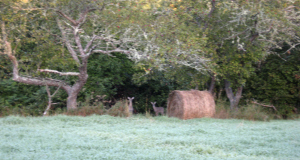
Round bales in autumn, with a couple of deer.
This problem can occur in all the aspects that go into the creation of a believable world or believable characters, but it happens particularly often in matters having to do with agriculture. Farming is a complex business; it goes on all around us, but most people never give it a moment’s thought, with embarrassing results for their fiction. My favourite example of “taking the present for granted” in this way has shown up in a number of otherwise scrupulously-researched and wonderfully-realized fantasy novels with a medieval-technological setting. In this article I’ll take this particular error as an example and demonstrate how to be aware of such anachronisms.
Suppose you’re writing a story. As your starting point you’ve created a society loosely modelled on that of Norman England — the setting is a country recently conquered by the ruling class of a neighbouring country. You’ve researched the feudal system and the manorial and have discovered that, contrary to what the high school history texts tell you, these two terms are not synonyms. You’ve read up on eleventh- and twelfth-century architecture, warfare, and government. You’ve considered the implications of a ruling class that speaks a different language from the majority of the population and the use of a third language for administration and the rituals of the priesthood. You’ve worked out your system of magic.
Your hero, Hilda, is a serf, a bastard with the stigma of the conqueror’s blood in her fathering and a power she doesn’t yet understand and can’t control beginning to manifest itself in dangerous ways. Hilda runs away to find her sorcerer-priest father and demand her heritage. The first night, unaware of her lord’s pursuit already close behind, Hilda breaks her journey in a barn, sleeping amid the sweet-smelling bales of hay.
And at this point, despite all the effort you’ve put into creating a convincing reality, you lose some of your readers. They no longer believe in your story; you’ve kicked them out of it. Why? A matter it never occurred to you to research, something you observed as you sped by on the highway, something you, like so many urban writers, took for granted.
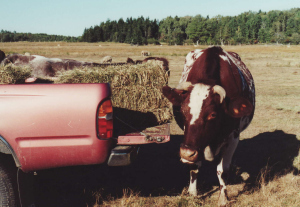
Square-baled hay. There are reasons that pickup trucks came before the baler. Are there pickup trucks in your pre-Industrial-Revolution fantasy world?
When writing a fantasy or an historical fiction, the author needs the readers to believe in the reality of the story. If it’s not real to the audience, how will the author keep them involved, make them care? Coleridge writes in Biographia Literaria of the need to create supernatural characters with whom the readers will nevertheless be able to identify, so as “to procure for these shadows of imagination that willing suspension of disbelief for the moment, which constitutes poetic faith” (London: Dent, 1975 (1817), pp. 168-169). In other words, if something in the characters, despite their existence as ghosts or demons, isn’t recognizable to the readers as something in themselves, they’re not going to care, and even in the most intense part of the story they’re not going to feel that it could be real. But this is true of all aspects of a story, not just its characters. If the world doesn’t have a coherent reality, it won’t win a sustained willingness on the part of the readers to enter into it.
You want to give your story what C.S. Lewis, in An Experiment in Criticism, calls “Realism of Presentation — the art of bringing something close to us … by sharply observed or sharply imagined detail” (Cambridge: Cambridge UP, 1961, p. 57). You attempt to do by describing your weary hero asleep in the scent of the hay, unaware of approaching danger. You want to convey the feel of a real barn, make your readers experience what Hilda is experiencing. But you inserted a glaring anachronism and completely destroyed that very realism of presentation you were trying to create.
They didn’t bale hay in the eleventh century.
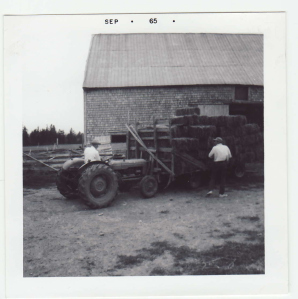
Assorted relatives putting hay into the young cattle barn, 1965. Not the Dark Ages. Not even the High Middle Ages. No, not even the nineteenth century.
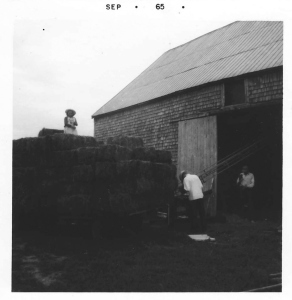
Anyway, baled hay is too firm for a good mattress.
It’s a fantasy novel, you might argue. You’re supposed to make things up. True enough. But they’ve got to be things that make sense within the reality of your story. And when it comes to both the natural world and agricultural matters, too many writers of fantasy and historical fiction don’t stop to think; they make jarring, careless mistakes that trip many readers into falling right out of the story. I don’t mean the apparent anachronisms that some writers deliberately use to reveal more about their world — often, that it has passed through our technological period and out the other side. I mean the small careless details intended to create a reality, which, when harshly incongruous with the rest of that world, have the opposite effect. Ripe peaches in early spring in a climate comparable to that of New York State? Not a chance, if there’s no way to fly them in from the opposite hemisphere. Hair “the colour of corn-silk” in an historical fiction of fifth-century Britain? Maize is a New World crop. Columbus is a thousand years away. Baled hay in a society with the technology of eleventh-century Europe? Highly improbable.
Here’s why that particular example, which shows up in far too many books, ruins my suspension of disbelief. Bear with me; I’m going into details here. It’s important to understand not only why they didn’t have balers in the real world, but why they’d be unlikely to have them in this particular made-up one. This is the sort of thing you should have been considering when you wrote that passage. Brace yourself for a history lesson and remember that baled hay is my chosen symptom of the problem, which covers anything dependent on the Industrial Revolution.
The stationary baler or hay press was invented in the 1850′s and wasn’t common until the 1870′s. The “pick up” baler, the modern square baler (now largely supplanted by round bales and bale-wrappers — and I recently read a medieval fantasy where the hay was in “rolls”, so I guess the round-baler has taken up time-travel as well) only came into being around the 1940′s. These dates are from International Harvester, but other equipment manufacturers would have been building the same types of machines around the same time. And the thing about balers is that, like the automobile, they have the whole Industrial Revolution looming behind them. They’re not something the village blacksmith whips up in his spare time. Sure, maybe he could have made a baling machine of some sort. But why would he, in a society that hadn’t experienced its Industrial Revolution? Would the investment of his time and materials have been worthwhile to him and his society? The Greeks, after all, did invent the steam engine, but they never used it for anything much. They didn’t need to. They had man- and woman-power.
From the Berry Hours: making hay in the early fifteenth century. Nothing changed much until the Industrial Revolution and the mowing machine – and it was still a long wait for the baler after that. (Limbourg brothers [Public domain], via Wikimedia Commons)
The Victorian hay press, like every other piece of technology, was invented to meet a need: the nineteenth century had more horses in cities than any other era, and the reasons for that are traceable to the great increase in the size of cities after the Industrial Revolution. Those horses needed to be fed, and the hay press facilitated the export of hay from country to city. Before that, most horses were kept fairly close to their food supply. People rarely needed to ship hay long distances, and when they did, it seems to have been packed in barrels (Ann Hyland, The Medieval Warhorse, Phoenix Mill: Sutton, 1994, p. 146). The modern baler came into being because of the decline in rural manpower over the last two centuries — people were leaving for the growing towns, for factories. Mowing machines, drop-rakes, and hay-loaders had been an answer to part of the problem, but by the middle of the twentieth century you couldn’t get a fork-wielding haying crew together. Baled hay was the solution to the problem of fewer people available to get the hay in.Except in certain rare periods, the Middle Ages, like classical Greece, didn’t have a enduring manpower problem. That came about as more people left rural villages for industrial towns. The real dividing line when you’re considering whether a technology is probable or even possible for your created culture is the Industrial Revolution. It’s not that everything pre- was “crude”; far from it. Try using a scythe instead of a motorized weed-trimmer and you’ll quickly find out which is the more elegant, refined, skill-demanding tool. But the Industrial Revolution changed the kind of work that people did and how they did it. And that’s something all fantasy writers should be aware of. You wouldn’t stick in a jet or a fibre-optic cable without a deliberate reason, but too many people, when it comes to farming matters, toss in without a second thought what they glimpse through the car window. They’re using images to which they’ve given no consideration at all as a shorthand to say “this is an agrarian society.” And they’re getting it egregiously wrong.
You don’t need to know the entire history of “hay-making through the ages” (though there’s a really interesting blog here with lots of photos), but you should be thinking a bit more about the evolution of technology and most importantly, the reasons for that evolution. A quick check can tell you that medieval hay was not baled. A bit of thought can explain why it would be unlikely to be baled in Hilda’s society.
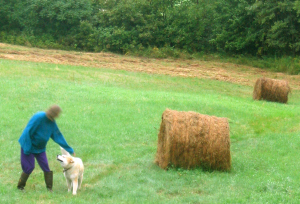
Pippin and I walk among the bales, which didn’t sprout like mushrooms, but required an internal combustion engine and rather a lot of diesel, among other things. (Rather out of focus through the kitchen window on a dim morning in 2006.)
So, whether you’re writing fantasy or historical fiction, which has the same pitfalls, the way to avoid jarring your readers loose from your story through such careless mistakes is, of course, to put a bit of thought into it. Keep the implications of the Industrial Revolution in mind. Do a bit of research. Give agriculture, arguably one of humanity’s oldest sciences, the respect you would any other field of knowledge. Admit you aren’t sure and look it up, the way you would Anglo-Norman jurisprudence or Samurai armour, if either of these formed an aspect of the culture you were portraying. A good encyclopaedia is an excellent place to begin. The basic “Life as a Medieval Peasant” type of book is also a reasonable resource to start with, although these latter tend to oversimplify and occasionally misunderstand more complex issues and machines. They’ll keep you from assuming hay sprouts up prepackaged, though. Their bibliographies can also lead you back to more detailed, scholarly works. Archaeological texts are a wonderful resource, as are plain, old-fashioned histories.
When you’re creating your medieval or even Victorian rural setting, give that setting a bit of respect. Don’t assume you know something about farming and the history thereof just because it’s not done by people who live in cities and must therefore be simple and obvious. Don’t take the present for granted. Don’t assume that nothing’s changed in the previous eight or ten thousand years of farming technology. We’ve been doing this for a long time; it’s humanity’s most fundamental industry; it drives every society save those which are hunter-gatherer or pure pastoralists. If you want to sustain your readers’ belief in your world, grant that world the dignity of a bit of thought. If you want Hilda to be snugly asleep in the hay when her pursuers overtake her, consider the various ways that hay was and could have been harvested and stored in that type of society. This isn’t something that needs to go into the story in detail; it’s just something you should be aware of, to avoid making silly mistakes. The background through which characters in fantasy or historical fiction move doesn’t have to be overbearingly detailed, but it should be more than wallpaper. If the world doesn’t feel real to the reader, how can the hero, and how can the story?
It’s your job, as a story-teller, to enable your readers to maintain that “willing suspension of disbelief” necessary to a complex and total enjoyment of your work. You want them to lose themselves totally in the reality of your world. When you disrupt that, jar them out of it, through simple careless incongruities and anachronisms, they come away with the impression that you haven’t made enough of a commitment to your story yourself to worry about its internal reality, its “reality of presentation.” And if you haven’t made that commitment, many of your readers will find that they can’t either.
#SFWApro


February 3, 2014
And wearing my other hat … SFF Masterclass this August
(Or one of my other hats …)
If you have found me here, I’m going to assume you’re interested in fantasy literature either for adults or children, or for both. Those of you who are also interested in the more academic side of science fiction and fantasy may be interested in checking out the information on the upcoming Eighth SFF Masterclass in Science Fiction Criticism, which is being offered in London over the three days before Loncon 3, the 2014 World Science Fiction Convention. The tutors will be Andy Duncan, Professor of English at Frostburg State University, winner of the Theodore Sturgeon Award and two World Fantasy Awards, and winner of the 2012 Nebula Award for Best Novelette; Neil Easterbrook, Professor of English at the Texas Christian University, whose monograph on China Miéville is due to be published in 2014; and K.V. Johansen, which is to say, me. And yes, shapeshifters, demons, cursed assassins, caravaneers, young gods, and camels notwithstanding, I have some fantasy-related litcrit to confess to as well. In addition to an o.p. ebook, there are two still-in-print works on the history of children’s fantasy literature, Quests and Kingdoms: A Grown-Up’s Guide to Children’s Fantasy Literature, and Beyond Window-Dressing: Canadian Children’s Fantasy at the Millennium.
The deadline to apply for this is February 28th, 2014. See the Science Fiction Foundation’s website for details.
Should be a very interesting three days.
#SFWApro


January 12, 2014
Dispatch from the Desk: 2014, A Year of Cons — Ad Astra, Loncon 3, DragonCon
This is going to be my year of cons. Not that I plan to make out like Moist von Lipwig or anything, but with two books, The Leopard and The Lady (volumes one and two of the two-part work Marakand) coming out from Pyr in June and the autumn respectively, it seemed to be the year to emerge from the backwoods/backwater/place-at-the-edge-of-the-country-that-nobody-abroad-has-heard-of and go conventioneering, though it’s hard to get there from here.
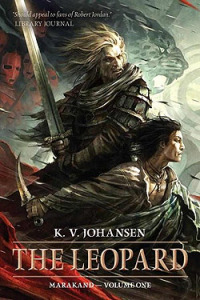
The Leopard: Marakand Book One, cover by Raymond Swanland
Doesn’t matter where “there” is; it’s hard to get to there from here.
I’m heading to Ad Astra in Toronto in April. This is the practice run. Last time I went to a con was . . . hmmm. Well, I’ve been a guest at InConsequential in Fredericton and a guest at Animaritime in Moncton twice, and attended Halcon as a representative of the Writers’ Federation of Nova Scotia on a recruiting drive a few years ago. And the first con I ever attended was Halcon as well, way back in the eighties. The Mount Allison Simulations and Gaming Association went to Halifax en masse, on the train (there were trains almost every day back in the dark ages), and slept all in a heap in one hotel room. I dyed my hair green for the occasion and was, along with a friend, seriously misquoted in the paper we called the Chronically Horrid saying it wasn’t what we expected. Or rather, that’s what we said, not what they said we said. Our Beloved Leader in MASAGA was somewhat displeased with us.
Anyway, Ad Astra in Toronto. (Okay, it’s a nice excuse to go to Toronto and see my friends there, too, and one of them, a more seasoned conventioneer, is going to come along to hold my hand. It’ll be fun. We can play undergrads again.) So Ad Astra will be the appetizer.
Then — the main course. I was invited to Loncon 3, which utterly floored me. Me? Go to London? But it’s not real, it’s a place in books. (My London is comprised of a strange amalgam of Edwardian children’s books and modern mysteries, with assorted lumps of history.) “In those days the Bastables were still looking for treasure in the Lewisham Road …” writes Lewis, and you know, they still are. Plus, watching New Tricks, we do keep expecting them to call in the Folly to help with some cold case or other. That’s London.

All set to see the real thing …
Real place or not, thanks in part to a travel grant from ArtsNB, and in part to assorted relatives for whom I am instructed to bring back lots of photos and assorted Twinings teas that are no longer sold in Canada because the parent company has apparently decided we are Americans and don’t need Vintage Darjeeling any more, I am able to go. So, if you are too, look for me! I’ll be reading from The Leopard at some point, and also taking part in panels, particularly one on children’s fantasy literature, wearing my “author of Quests and Kingdoms and Beyond Window-Dressing” hat.
My third con will be DragonCon in Atlanta in the US. That one’s almost definite, though I’m still waiting to hear if a few other people are going, before I utterly commit. After Loncon, thought of it is not as intimidating as it was. And the travel time is actually longer.
#SFWApro



![From the Berry Hours: making hay in the early fifteenth century. Nothing changed much until the Industrial Revolution and the mowing machine. (Limbourg brothers [Public domain], via Wikimedia Commons)](https://i.gr-assets.com/images/S/compressed.photo.goodreads.com/hostedimages/1393205595i/8676447._SY540_.jpg)


